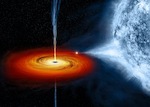The mass of the black hole's companion

If you read the background on Cygnus X-1, then you learned that the black hole's companion is a blue supergiant star classified as a type OB star. Your textbook talks at length about stellar classifications. Type O stars are the hottest while Type B are the second hottest stars out there. Type OB stars are defined as Type O or B stars that are found in groupings that all formed from the same cloud of gas.
Flipping back through your book to the section on stellar classifications, it says that Type O stars have masses between 15 and 90 times the mass of our sun and Type B stars have masses between 2 and 16 times the mass of our sun. That's quite a range of masses!
As a type OB star, it is likely on the lower end of the Type O mass rather than the higher end. You decide you can narrow down the mass to around 30 times the mass of our sun, or 30 solar masses (usually shortened to 30 M⊙, since ⊙ is the symbol for the sun).
Don't forget to make a note of this – you'll need it to solve the equation!
 Return to solving the binary equation for the black hole mass
Return to solving the binary equation for the black hole mass


